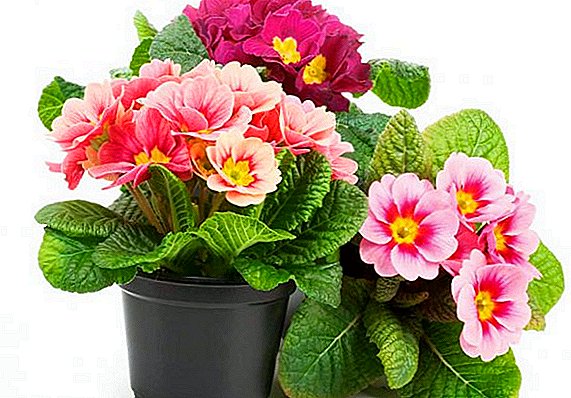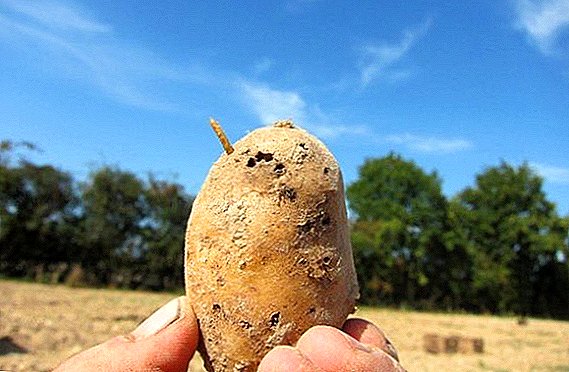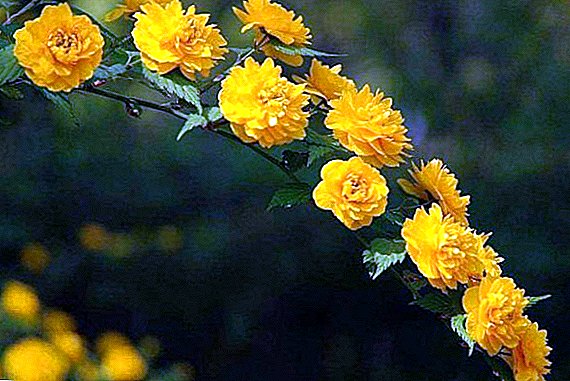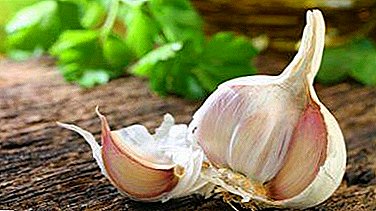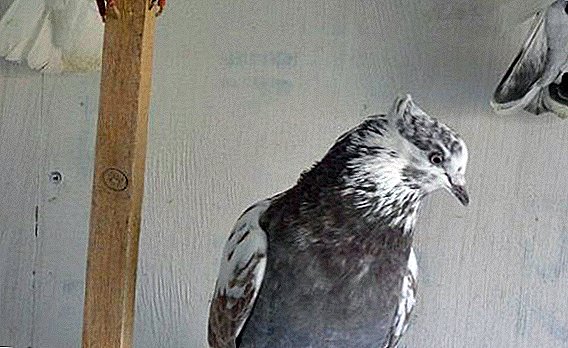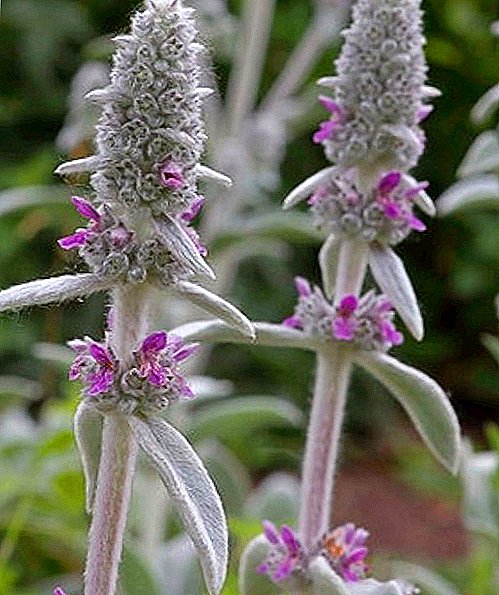 Stahis (or Chiselie) is most common in Central Asia, but it is grown all over the world, except Australia and New Zealand. The plant is annual, in countries with warm climates it is perennial. With all this, his tubers are not afraid of severe frosts. On the territory of the former USSR, the Chistere called "sheep (or bear) ears." Over the past 50 years, in the territory of our country, this plant has practically disappeared from the gardens of gardeners, but recently it has been actively begun to return to our garden crop.
Stahis (or Chiselie) is most common in Central Asia, but it is grown all over the world, except Australia and New Zealand. The plant is annual, in countries with warm climates it is perennial. With all this, his tubers are not afraid of severe frosts. On the territory of the former USSR, the Chistere called "sheep (or bear) ears." Over the past 50 years, in the territory of our country, this plant has practically disappeared from the gardens of gardeners, but recently it has been actively begun to return to our garden crop.
Choosing a place for growing stakhis
The plant can actively grow on almost any type of soil. Stahisa tubers grow well on black soil, podzols and light sandy loams. However, Chisel can grow even in clay soil, not paying attention to the high humidity.
Important! It is good if onions or tomatoes were previously growing on the site of the stakhis plant.The best place for planting this plant will be partial shade. It is good if onions or tomatoes were previously growing on the site of the stakhis plant. Chista is much like a potato, therefore, the principle of care for these plants is very similar. When planting soil acidity should be neutral.
Preparation before landing
The plant is genetically protected from all sorts of diseases. It is not infected by viruses or bacteria, and even if the damage occurs, the stahis themselves cope with the pest. Stachis with proper fit and proper care gives up to 15 kg tubers on 1 m². 
Soil preparation
It is best to plant Chistitse autumn. This plant is not afraid of severe frosts and snowless winters, so it easily survives in our harsh climate.
There are cases when stachis are planted in the soil in winter or in early spring, punching holes with scrap. And with all this in the spring, the plant begins to actively grow.
Stahisa tubers grow well between raspberry or currant bushes.If you are planting sheep's ears for the first time, it is best to do this in the fall. First you need to dig the earth, and then make a little organic and mineral fertilizers.
For 1 m² it is worth making about 10 kg of humus, 2 kg of ammonium nitrate, 2.5 kg of superphosphate and 4 kg of potassium salt.
Stakhis vegetable - A tasty plant resembling asparagus or cauliflower, therefore, nitrogenous fertilizers should not be applied (such compounds kill the taste).
Did you know? Translated from the Latin "stahis" means "ear"Chistet breeds tubers, so they need to be planted no more than 4-5 pieces per 1 m². After planting, the Chivet will grow in the same place for about 10 years, and the yield will not decrease.
 If desired, it can be transplanted and propagated, while the stakhis will not dry out.
If desired, it can be transplanted and propagated, while the stakhis will not dry out.Tuber preparation
Stahis is very resistant to various diseases, so it is unnecessary to especially prepare or kill the tubers of this plant.
It is enough to take a pinkish solution of potassium permanganate and rinse the tubers in it for 20 minutes. This is done to disinfect the rhizomes.
Stakhis planting rules
This plant is not whimsical to weather conditions. Therefore, planting can be done both in spring and autumn. 
Optimal timing
If you plant this plant in the fall, the most favorable period will be the second decade of October. It will easily overwinter and will begin to actively grow in spring.
Important! Insofar as The stakhis growing season is about 5 months; in cold climatic zones, the plant can be planted immediately after the snow melts.If the Chista plant is to be planted in the spring, this should be done at the end of March or the beginning of April. The plant has a very long growing season (130-150 days), so if the plant is late to plant, this period may not end correctly, and the tubers will not be fit for human consumption.
Scheme and depth
Planted tubers need to depth 10-12 cm. The row spacing should not exceed 70 cm. The distance between the individual parts of Chistac, according to optimal standards, is about 40 cm.
Thus, the bush can grow normally, receive the correct dose of sunlight, water and fertilizer.
Mulching
Stachis when growing need to mulch. This is done with the help of last year’s leaves, rotted compost, sun-dried weeds or sawdust soaked in water.
If you add only fine straw, you can attract mice that will damage the stahis tubers.
Mulching is best done together with hilling bushes. First you need to sprinkle the soil with mulch, and then pile up the plant. Thus, many organic nutrients will start to get into the root system.
Care Tips
Many gardeners unanimously claim that the chisel grows well without much care. It takes only a few times a year to water the plant. However, proper care for him will lead to an increase in his tubers, which are used in cooking.
Did you know? More than 300 plant species belong to this genus of perennial herbs.
Watering, weeding and loosening the soil
It is necessary to water stahis only during the dry months of summer. "Sheep ears" - very unpretentious plantwhich does not require a special method of irrigation.  Weeding should be done only if the plant is densely deposited various weeds. This is done with a small hoe, cutting off weeds in the upper soil layer. It is not recommended to drive the tool deeply, as it is possible to damage the stakhis tubers.
Weeding should be done only if the plant is densely deposited various weeds. This is done with a small hoe, cutting off weeds in the upper soil layer. It is not recommended to drive the tool deeply, as it is possible to damage the stakhis tubers.
Loosening the soil is carried out together with weeding. Rakes a little beat up large lumps of earth, for a better flow of water and minerals into the soil.
Hilling
Stakhis is a moisture-resistant plant, so some gardeners are not engaged in the hilling of a bush. However, agronomists are advised to use it in order to avoid the formation of a hard crust around the choiser. Spud need to be very careful not to touch the stakhis tubers.
Important! After mid-August, the Chisteau cant weed and spud, since there is a risk of damaging the roots.To do this in early August. Then begins a period of rain, and the plant must be prepared for the fact that the soil may be washed away due to heavy rainfall.

Top dressing
Feed the Chistere must be twice a month with ordinary manure. To do this, dilute the spade of the specified fertilizer in 10 liters of water and pour it under the bush.
To introduce potash or nitrogenous fertilizers since the beginning of August is prohibited, because the stakhis start to form tubers. Nitrous and potash minerals can give tubers a bad taste.
Cleaning and storage of stakhis tubers
Stakhis harvesting begins in early September and lasts until mid-October. It all depends on the climate of a particular region. The first sign for harvesting will be slightly yellowed or dried leaves of Chistac.
Digging tubers need the same way as potatoes. The largest tubers should be left for planting next year.  If you want to leave some roots in the ground, then sprinkle them with old leaves, and they successfully winter the hard frosts right in the soil. With one planted tuber, you can collect about 30 new ones.
If you want to leave some roots in the ground, then sprinkle them with old leaves, and they successfully winter the hard frosts right in the soil. With one planted tuber, you can collect about 30 new ones.
Store chisets for landing next season in boxes with sand, at a temperature not exceeding + 3º С.
If the temperature is warm enough, the tubers can sprout ahead of time. You can store stachis for food in the freezer.
Useful properties of stakhis
Stakhis found his description in many botanical references. In the wild, it can be found only in some mountainous areas. Of china and Mongolia.
The peoples of these countries have been using medicinal herbs. You can eat both leaves and tubers.
Did you know? "Byzantine Chistets" - an ornamental plant with silver-white leaves.Salads are made from green leaves, and tea is made from slightly dried ones. Stahisa tubers can be fried or boiled. In taste, they resemble asparagus or cauliflower.
 Children with great pleasure can chew on the root in its raw form. Due to the absence of starch in the stakhis, it is possible, and even necessary, to be used by diabetics. Chistets has the properties of insulin and helps reduce blood sugar.
Children with great pleasure can chew on the root in its raw form. Due to the absence of starch in the stakhis, it is possible, and even necessary, to be used by diabetics. Chistets has the properties of insulin and helps reduce blood sugar.Also "sheep ears" contribute pressure reduction in hypertensive patients. The benefits of this plant extend to the respiratory and digestive systems. Chisel can be used for impotence.
To grow such a plant is very easy right in your country house. Without spending a lot of time and effort, you will end up with a healthy and tasty product.


